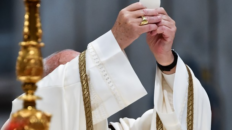Perhaps no other devotion or prayer, save the Pater Noster, is the center of Catholic reverence than the Rosary. As members of the faithful we keep them close by in our homes and cars, carrying them everyday in our pockets and purses. Despite being a prayer of ubiquity, the thought may never have crossed your mind: how did the Rosary get its name?
The first recorded use of the English word “Rosary” in the strict sense was over 400 years ago in 1597, but the history of one of the Church’s most popular prayers goes back much further.
The use of beads for the repetition of prayer to aid contemplation stems from the earliest days of the Church. Even before the apparition of the Blessed Virgin to Saint Dominic, monks and friars would recite all 150 Psalms as part of their daily prayers and devotions.
They would count out 150 pebbles from a pouch to keep track. Over time laity began using string with knots in it, eventually giving way to pieces of wood. Laity would pray Our Fathers, Paternosters, instead of the psalms as few could memorize them all with a lack of printing presses.
As the tradition of the Rosary developed, so did the usage of rosary beads to pray – a word we have the rosary thank for. Bead comes from the middle English bede, literally meaning “a prayer.”
The word rosary itself comes from the Latin rosarium, meaning a garden or garland of roses. During the Middle Ages, agriculture metaphor was the literary choice du jour. Writing drew comparisons to plowing a field, and collecting prayers was seen as growing a garden or arranging a bouquet. In the most literal sense, the Rosary is a “garden” or “boquet” of prayers.
Symbolic associations with roses and the Blessed Virgin abound Catholicism. Medieval Latin Rosarium was used to refer to a “rose garland for crowning the Virgin.” Over time, the association between the Rosary and rose imagery strengthened – its not hard to imagine that a string of beads can look like a bouquet of flowers. Marian flower symbolism worked its way into the etymological roots of many English words today: the marigold and even the passionflower referring to Mary and the Passion of Christ.
“The rose of charity, the lily of chastity, the violet of humility and the golden gillyflower of heaven.” – Saint Bernard on the Virgin Mary, 12th century.
Pious tradition attributes the association to:
“an early legend which after traveling all over Europe, penetrating even to Abyssinia, connected this name with a story of Our Lady, who was seen taking rosebuds from the lips of a young monk when he was reciting Hail Marys and to weave them into a garland which she placed upon her head.” – Catholic Encyclopedia
“The Rosary is the book of the blind, where souls see and there enact the greatest drama of love the world has ever known; it is the book of the simple, which initiates them into mysteries and knowledge more satisfying than the education of other men; it is the book of the aged, whose eyes close upon the shadow of this world, and open on the substance of the next. The power of the Rosary is beyond description.” – Venerable Archbishop Fulton J. Sheen





